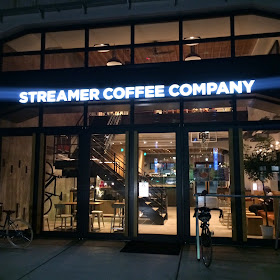 |
| Dawn Looking toward Sekidobashi |
 |
| Early Light Crossing the Tamagawa |
Jerome is planning another winter trip by bicycle to Osaka, where he has a meeting on Monday. This time he will try the inland (i.e. mountainous) route, since the weather forecast is decent -- a few degrees warmer than at end of December, though still below freezing for the first 5 hours and again for at least another 14-16 hours from late afternoon as he enters Nagano to morning in Nagoya on Sunday!
 |
| Light shines from the heavens onto Futako Shinchi |
I felt the least I could do was give him a pull out of town, so I woke up early, threw on my warm gear, and left around 4:20AM. As we rode through Machida and Sagamihara, we decided to stop at a "Gusto" family restaurant at Lake Tsukui for a quick breakfast and warm-up, before I would head back into town for my day's activities.
Unfortunately, the Gusto was closed! No signs of activity at 6AM. Too many of these places are no longer open 24 hours. I guess old people in the countryside do not frequent overnight restaurants. In any event, the Family Mart up the street had a place to eat (and sip hot coffee) inside the store, so we made do with it.
 |
| Jerome checks weather on his ride route |
 |
| We say farewell. Jerome puts on the warm gear for a cold morning ride up to Sasago and beyond! |
Then a fast ride back into town. And now I get to start my day. All in all much more exercise than I had hoped for today ... though at the expense of a bit of sleep.
Stay tuned for any reports of Jerome's progress.
JEROME UPDATE: After we parted, Jerome made steady progress up Route 20 (Koshu Kaido) through Uenohara, Sarubashi, Otsuki and to the mouth of the Sasago Tunnel. As with the Fellowship of the Ring, Jerome knew that evil lurked deep in the mountain, and so chose the beautiful, deserted road to Sasago Pass.
I wish he would have asked me, since I would have told him this would almost certainly be blocked with snow. Indeed, it was blocked with snow when I tried it once in mid-March. So in late January ... not likely passable. Of course, it was not. But in addition, there is the well known "witch of Sasago Pass". We have only actually seen her once, as we climbed through mist up the other side of the pass several years ago, and came upon an old hag-like woman wandering around, who asked us if we knew of a "yado" (lodging) nearby.
But her work was in evidence on Saturday, as she had strewn debris on the road, resulting in a flat tire, even before he started the portage section on snow and ice.
 |
| Debris blocks the road |
In the end, Jerome made it to the pass and the entrance to its short, pitch-dark tunnel.
 |
| Sounds and smells of the witch emerge from the pitch black tunnel mouth |
But he was driven near-mad in the effort. And the witch noises (and smells) emitting from within her tunnel lair persuaded him to turn back ... and go down the hill again.
 |
| Jerome -- near mad with frustration. |
So Jerome went back down the hill and, now several hours behind his planned schedule, decided that rather than going on through Sasago Tunnel, he would return to Tokyo. Another ill-conceived plan for mid-winter ride to Kansai via the mountains was cast aside! The disappointed rider returned home, only to seek a more traditional transport mode that will get him to Osaka Monday meeting.
Still, he logged around 200 kms. Not bad for a Saturday in January.
*According to
his Strava track, Jerome now has recorded the fastest time in 2015 on numerous segments, with speeds of 2.6 kph on the upper part of the Sasago Pass climb (where he changed a flat then walked in snow). Strava really needs to get rid of the "fastest this calendar year" feature and try a "fastest in last 365 days" feature instead! And it appears that he actually DID make it through the witch tunnel and down the other side of the mountain, before returning through the main Route 20 tunnel and back to Tokyo.














































